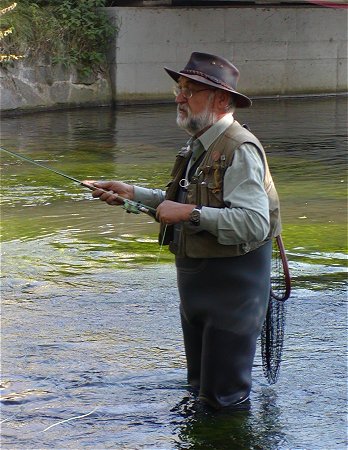
I have already told you that fly fishing is possible in all types of fishing grounds and that by this technique we can catch almost all kinds of fish with greater or lesser probability. Water and some terrestrial insects and other small animals are the predominant component of trout and lipan food, but also an attraction for other fish - predatory, omnivorous and unhealthy. In addition, artificial fly can not be imitated only by insects, but other animals, including fish, pulses, leeches, crustaceans, even eggs or cubes of floating bread can be imitated. What is important is that it is an artificial fly, an artificial bait attached to a hook and made mainly of feathers, coats or their artificial imitations and offered to fish by fly fishing, ie by a flywheel without a float and without the burden of the olivy, Therefore, no fly fishing can be taken into account between fly fishing, such as hunting with a round sailboat, Bavarian tree or broccoli or mother at the end of the ride, or even fishing by fly fishing technique, where the small glitter, twister ap. Fly fishing is knightly sport and the knight should adhere to unspoken but clear principles.
Still, flyfishing is sufficiently varied. We can hunt "dry", ie to offer fish a fly floating on the surface or in the water level. When hitting "wet" we bind the fly so that it sinks and catches the entire water column. When "nymphing" we hunt more at the bottom or directly so that the end fly "licks" on the bottom. "Straining" is a way of fly fishing, when the fly is attracted by pulling hands by the cord and mimicking the movement of a fish or active insect or other animal.
We use different flies for different hunting methods. From this point of view, we can also divide it. This is a basic but very rough division. Nothing in fly fishing is anything but "black or white". There are a number of temporary options. However, each flywheel should be based on this principle.
Dry flies are made from well-floating and non-absorbent materials and hooks made of thinner and lightweight wires. This is to keep the fly as long as possible. A wet fly usually represents an already drowned insect that has fallen below the surface and is passively entrained by the stream or in still water slowly falling to the bottom. It is therefore bound to heavier hooks and softened and absorbent materials. The nymph most often mimics the active insect larva at different stages of development, which for some reason has left its shelter under the stone or in aquatic plants and is moving elsewhere. Stromr is an artificial fly that imitates a fish, a pullet or other animal floating in the water and its irritating movement provokes predatory fish to attack.
By dry fly we catch fish that collect food from the surface. They are revealed by characteristic rings or in sparkling water by splashing. They are mainly hazelnuts, trout and wheatgrass, all kinds of crustaceans, roach, pearl, and sometimes hurt. Most often we offer the fly in such a way that without floating the surface, it flies into the fish field. Occasionally, the obstacle provokes the fish to sharply engage. Wet flies are drifting in streams and tongues, allowing them to freely spill, occasionally we can rejuvenate them with a small percussion on the cord or the tip of the rod. Nymphs are most often hunched in the streams by throwing it obliquely upstream, letting it fall to the bottom and float under the stream. In the standing and quiet nymphs water very gently and with interruptions we attract the wrapping of the cord by hand. The catch of carp or clover is no exception. Strips are sloped upside down, let them merge under and then attract at different speeds. We often hunt for them even in stagnant waters. In addition to trout, fishing is also pike, fat, perch, bolen and parma.
Next time we start talking about flies mimicking insects and other types of flies and ways of hunting them. However, the basic division indicated in this continuation remains the same.












